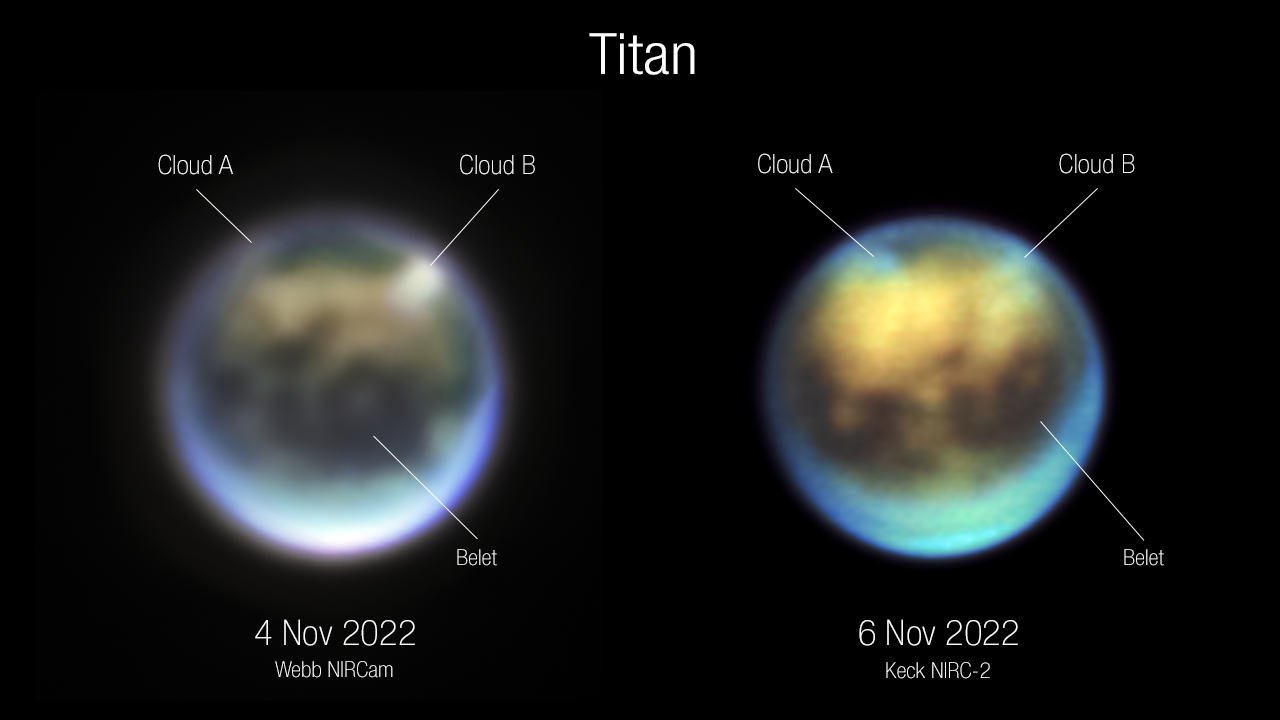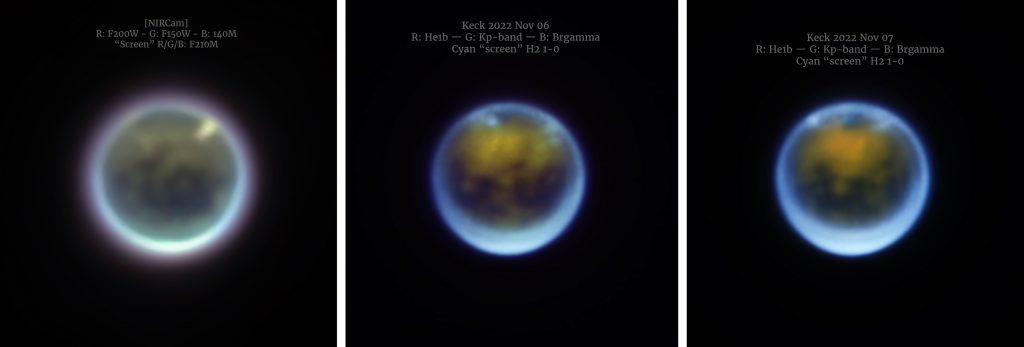James Webb Space Telescope view of Saturn's weirdest moon Titan thrills scientists
It's been a cloudy season for Saturn's largest moon, Titan.
Titan is a strange world — a little bit Earthlike, if land were made of water ice, rivers and seas were filled with liquid methane and other hydrocarbons, and the atmosphere were thick and hazy, dotted with methane clouds. And now, the James Webb Space Telescope (Webb or JWST) has observed two of those clouds during observations on Nov. 4 that have thrilled scientists, according to a NASA statement.
"Fantastic! Love seeing the cloud and the obvious albedo markings," Heidi Hammel, a planetary scientist at the Association of Universities for Research in Astronomy and a project lead for JWST's solar system work, wrote in an email shared in the statement, referring to glimpses of bright and dark regions of Titan's surface.
Related: Dazzling views show Saturn moon Titan's surface like never before

Conor Nixon, an astronomer at NASA's Goddard Space Flight Center in Maryland, arranged for JWST to spend a total of 15 hours of its first year studying Titan. In particular, Nixon's team wanted to study Titan's atmosphere, aiming to map the distribution of the haze and identify new gases, among other goals.
And the scientists were thrilled at the data JWST sent them. "At first glance, it is simply extraordinary," Sebastien Rodriguez, an astronomer at the Université Paris Cité and colleague on the research, wrote in an email shared in the statement. "I think we're seeing a cloud!"
As they pored over the data, the researchers identified not one but two clouds, including, intriguingly, one located over Kraken Mare, the largest of Titan's seas. The scientists were soon inspired to find a way to check back in on those clouds to understand how they changed over time. The team reached out to the Keck Observatory in Hawai'i, which was able to snag observations of Titan just two days after JWST.
Get the Space.com Newsletter
Breaking space news, the latest updates on rocket launches, skywatching events and more!

"We were concerned that the clouds would be gone when we looked at Titan two days later with Keck," Imke de Pater, an astronomer at the University of California, Berkeley, who leads Keck's observations of Titan, said in the statement. "But to our delight there were clouds at the same positions, looking like they had changed in shape."
However, that alignment doesn't necessarily mean Keck saw the same clouds as JWST. Scientists expected high cloud activity because Titan's northern hemisphere is experiencing late summer and catching more solar radiation, so Keck's clouds may have been freshly formed.
And the scientists aren't done mining the observations. They identified the clouds in images taken by JWST's Near-Infrared Camera (NIRCam), a powerful camera that can image a target in several different wavelengths of light, which in the case of Titan allows scientists to separate out the lower atmosphere.

But the researchers haven't even finished evaluating all of NIRCam's data, and a second instrument was also at work. The observatory's Near-Infrared Spectrograph (NIRSpec) gathered spectra. This technique splits light reflected off, for example, Titan's atmosphere and measures how much of each wavelength of light is present. The spectra should help scientists map what compounds are present in the lower atmosphere — including a strange bright spot over the moon's south pole.
JWST is also scheduled to return its sharp gaze to Titan in May or June 2023, according to the statement, this time using its Mid-Infrared Instrument (MIRI), which will refine scientists' understanding of the chemicals in the moon's strange, hazy atmosphere.
Observations of Titan are particularly important now, in a lull between spacecraft visitors to the icy moon. NASA's Cassini mission arrived at Saturn in 2004 and flew past the moon more than a hundred times before the spacecraft's demise in 2017. And NASA is working on a new mission, called Dragonfly, which is dedicated to Titan and will see a drone flying through the hazy skies, allowing scientists to study the moon from some two dozen vantage points.
Email Meghan Bartels at mbartels@space.com or follow her on Twitter @meghanbartels. Follow us on Twitter @Spacedotcom and on Facebook.
Join our Space Forums to keep talking space on the latest missions, night sky and more! And if you have a news tip, correction or comment, let us know at: community@space.com.

Meghan is a senior writer at Space.com and has more than five years' experience as a science journalist based in New York City. She joined Space.com in July 2018, with previous writing published in outlets including Newsweek and Audubon. Meghan earned an MA in science journalism from New York University and a BA in classics from Georgetown University, and in her free time she enjoys reading and visiting museums. Follow her on Twitter at @meghanbartels.
-
rod Some images of Titan here :) My 90-mm refractor and 10-inch Newtonian telescopes do not show Titan like that :) I checked Stellarium for 05-Nov. Titan listed as 0.73 arcsecond angular size. Impressive views of Titan.Reply -
MikeCollinsJr Reply
Thanks, Meghan. Do we have any videos yet at this resolution? --Stone PhillipsAdmin said:It's been a cloudy season for Saturn's largest moon, Titan.
James Webb Space Telescope view of Saturn's weirdest moon Titan thrills scientists : Read more









